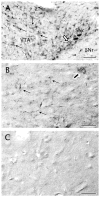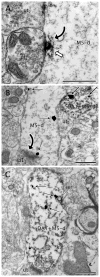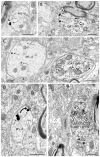Somatodendritic targeting of M5 muscarinic receptor in the rat ventral tegmental area: implications for mesolimbic dopamine transmission
- PMID: 23504804
- PMCID: PMC4038040
- DOI: 10.1002/cne.23323
Somatodendritic targeting of M5 muscarinic receptor in the rat ventral tegmental area: implications for mesolimbic dopamine transmission
Abstract
Muscarinic modulation of mesolimbic dopaminergic neurons in the ventral tegmental area (VTA) plays an important role in reward, potentially mediated through the M5 muscarinic acetylcholine receptor (M5R). However, the key sites for M5R-mediated control of dopamine neurons within this region are still unknown. To address this question we examined the electron microscopic immunocytochemical localization of antipeptide antisera against M5R and the plasmalemmal dopamine transporter (DAT) in single sections through the rat VTA. M5R was located mainly to VTA somatodendritic profiles (71%; n = 627), at least one-third (33.2%; n = 208) of which also contained DAT. The M5R immunoreactivity was distributed along cytoplasmic tubulovesicular endomembrane systems in somata and large dendrites, but was more often located at plasmalemmal sites in small dendrites, the majority of which did not express DAT. The M5R-immunoreactive dendrites received a balanced input from unlabeled terminals forming either asymmetric or symmetric synapses. Compared with dendrites, M5R was less often seen in axon terminals, comprising only 10.8% (n = 102) of the total M5R-labeled profiles. These terminals were usually presynaptic to unlabeled dendrites, suggesting that M5R activation can indirectly modulate non-DAT-containing dendrites through presynaptic mechanisms. Our results provide the first ultrastructural evidence that in the VTA, M5R has a subcellular location conducive to major involvement in postsynaptic signaling in many dendrites, only some of which express DAT. These findings suggest that cognitive and rewarding effects ascribed to muscarinic activation in the VTA can primarily be credited to M5R activation at postsynaptic plasma membranes distinct from dopamine transport.
Keywords: acetylcholine; motivation; reinforcement; reward; ultrastructure.
Copyright © 2013 Wiley Periodicals, Inc.
Conflict of interest statement
The authors declare that they have no conflict of interest.
Figures







Similar articles
-
Cholinergic axon terminals in the ventral tegmental area target a subpopulation of neurons expressing low levels of the dopamine transporter.J Comp Neurol. 1999 Jul 26;410(2):197-210. doi: 10.1002/(sici)1096-9861(19990726)410:2<197::aid-cne3>3.0.co;2-d. J Comp Neurol. 1999. PMID: 10414527 Review.
-
Subcellular distribution of M2 muscarinic receptors in relation to dopaminergic neurons of the rat ventral tegmental area.J Comp Neurol. 2006 Oct 20;498(6):821-39. doi: 10.1002/cne.21082. J Comp Neurol. 2006. PMID: 16927256 Free PMC article.
-
Targeting of serotonin 1A receptors to dopaminergic neurons within the parabrachial subdivision of the ventral tegmental area in rat brain.J Comp Neurol. 2001 May 7;433(3):390-400. doi: 10.1002/cne.1147. J Comp Neurol. 2001. PMID: 11298363
-
Predominant surface distribution of neurokinin-3 receptors in non-dopaminergic dendrites in the rat substantia nigra and ventral tegmental area.Neuroscience. 2007 Feb 23;144(4):1393-408. doi: 10.1016/j.neuroscience.2006.10.058. Epub 2006 Dec 29. Neuroscience. 2007. PMID: 17197098
-
Electron microscopic immunolabeling of transporters and receptors identifies transmitter-specific functional sites envisioned in Cajal's neuron.Prog Brain Res. 2002;136:145-55. doi: 10.1016/s0079-6123(02)36014-x. Prog Brain Res. 2002. PMID: 12143378 Review.
Cited by
-
Electron microscopic localization of M2-muscarinic receptors in cholinergic and noncholinergic neurons of the laterodorsal tegmental and pedunculopontine nuclei of the rat mesopontine tegmentum.J Comp Neurol. 2016 Oct 15;524(15):3084-103. doi: 10.1002/cne.24010. Epub 2016 Apr 21. J Comp Neurol. 2016. PMID: 27038330 Free PMC article.
-
Physiological roles of CNS muscarinic receptors gained from knockout mice.Neuropharmacology. 2018 Jul 1;136(Pt C):411-420. doi: 10.1016/j.neuropharm.2017.09.011. Epub 2017 Sep 11. Neuropharmacology. 2018. PMID: 28911965 Free PMC article. Review.
-
Functional Characterization of Cholinergic Receptors in Melanoma Cells.Cancers (Basel). 2020 Oct 27;12(11):3141. doi: 10.3390/cancers12113141. Cancers (Basel). 2020. PMID: 33120929 Free PMC article. Review.
-
NMDA Receptor-Dependent Cholinergic Modulation of Mesolimbic Dopamine Cell Bodies: Neurochemical and Behavioral Studies.ACS Chem Neurosci. 2019 Mar 20;10(3):1497-1505. doi: 10.1021/acschemneuro.8b00492. Epub 2018 Nov 21. ACS Chem Neurosci. 2019. PMID: 30412381 Free PMC article.
-
Examining the role of muscarinic M5 receptors in VTA cholinergic modulation of depressive-like and anxiety-related behaviors in rats.Neuropharmacology. 2020 Jul;171:108089. doi: 10.1016/j.neuropharm.2020.108089. Epub 2020 Apr 5. Neuropharmacology. 2020. PMID: 32268153 Free PMC article.
References
-
- Achour L, Labbé-Jullié C, Scott MGH, Marullo S. An escort for GPCRs: implications for regulation of receptor density at the cell surface. Trends Pharmacol Sci. 2007;29:528–533. - PubMed
-
- Alderson HL, Latimer MP, Blaha CD, Phillips AG, Winn P. An examination of d-amphetamine self-administration in pedunculopontine tegmental nucleus-lesioned rats. Neuroscience. 2004;125:349–358. - PubMed
-
- Augelli-Szafran CE, Blankley CJ, Jaen JC, Moreland DW, Nelson CB, Penvose-Yi JR, Schwarz RD, Thomas AJ. Identification and characterization of m1 selective muscarinic receptor antagonists1. J Med Chem. 1999;42:356–363. - PubMed
Publication types
MeSH terms
Substances
Grants and funding
LinkOut - more resources
Full Text Sources
Other Literature Sources
Molecular Biology Databases

